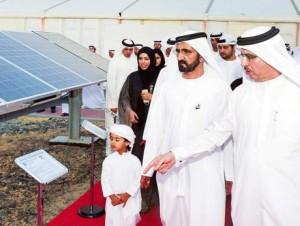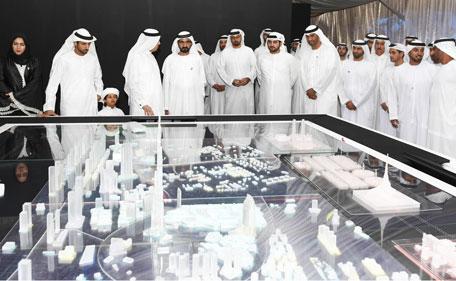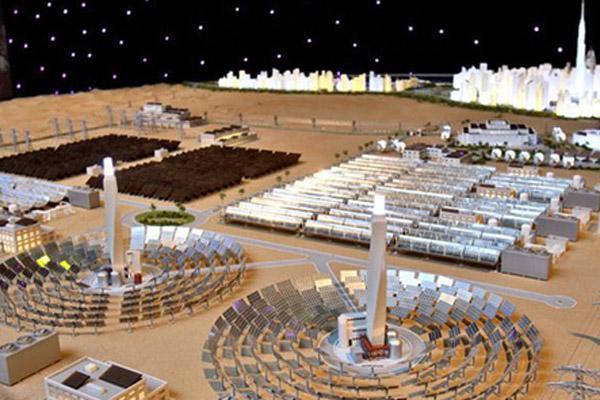Here in the United States, climate change is a seriously divisive issue among politicians. Some claim it doesn’t exist, or that it exists but has nothing to do with human behavior, or that it exists but isn’t important enough to warrant changing our behavior, and some happily ignore it altogether. Others acknowledge it as a serious problem that needs immediate attention, but can’t agree on how best to address the problem. I won’t go into my own personal feelings on the issue, because I could go on for hours. I will say this, however – we in the US could learn a lot from the United Arab Emirates.
The UAE is in no danger of running out of oil anytime soon, but they’ve still made it a priority to use less. The country is leading globally in clean, renewable energy investments, and Dubai has announced that it intends to become the world’s most energy-efficient city by 2050. The city has made a good start – earlier this month we covered its 3D printed, solar-powered Smart Palms, which were invented as part of the city’s Smart Dubai initiative that aims to make Dubai the global leader in smart technology within three years.
Smart technology is a big part of the Dubai Clean Energy Strategy 2050, but it’s not the only part. The strategy, as described by Sheikh Mohammed Bin Rashid Al Maktoum, Vice President and Prime Minister of the UAE and Ruler of Dubai, consists of five pillars: infrastructure, legislation, funding, building capacities and skills.
Becoming the world’s cleanest city by 2050 is the ultimate goal, but there are several mile markers along the way: Dubai intends to rely on clean energy sources for 7 percent of its power by 2020 and 25 percent by 2030, raising the number to 75 percent by 2050. Also by 2030, every building in Dubai is expected to have solar panels installed on its roofs.
The announcement of the Dubai Clean Energy Strategy 2050 was made at the Mohammed Bin Rashid Al Maktoum Solar Park, an ambitious project that was started in 2013 and is already the largest solar park in the world. Phase 2 of its construction was just begun, and is expected to eventually cover 40 square kilometers and produce 1,000 megawatts of clean energy. Dh500 million has been invested in the project, and an additional Dh100 billion has now been invested in the city’s Green Fund, which was created earlier this year.
“Every investment in the development of clean energy sources is at the same time an investment to protect the environment for future generations,” said Sheikh Mohammed. “It is an effort to build our sustainable economic sectors which do not depend on nonrenewable energy resources and are unaffected by volatile energy prices. Through this strategy, which is based on innovation, research and development, we aim to explore the future of the energy sector to unveil initiatives that will make use of the scientific and technological developments in this sector and take the lead in their development and application.”
One of those technological developments is 3D printing. Part of the infrastructure portion of the initiative will include the construction of an innovation center, which will rely heavily on 3D printing technology. Once completed, the innovation center will be a base for the research and development of clean energy technology, including 3D printing as well as solar energy, drones, and smart grids. Sheikh Mohammed has encouraged companies all over the world to consider Dubai as a base for testing and applying clean energy technologies.
Dubai has already shown a great deal of ingenuity in terms of using the latest technologies to reduce its carbon footprint; it’ll be exciting to see what the city can generate within the new strategy and the billions of dollars invested in it. Dubai intends to become an example for the rest of the world, and I hope the world takes notice.
We have more technology at our fingertips than ever before, and Dubai has already proved that it can be used in a myriad of ways to cut pollution. If the country with the second-largest oil reserves in the world can figure out how to stop relying on harmful fuel consumption, then what excuse do the rest of us have? Discuss this story in the Dubai 3D Printing forum thread on 3DPB.com.
Subscribe to Our Email Newsletter
Stay up-to-date on all the latest news from the 3D printing industry and receive information and offers from third party vendors.
You May Also Like
3DPOD Episode 198: High Speed Sintering with Neil Hopkinson, VP of AM at Stratasys
Neil Hopkinson, a pioneering 3D printing researcher, played a pivotal role in developing a body of research that is widely utilized today. He also invented High Speed Sintering (HSS), also...
GE Additive Transforms into Colibrium Additive in New Brand Move
One of the largest and most compelling companies in the 3D printing industry, GE Additive, has undergone a rebrand. Now, known as Colibrium Additive, the company and its new name...
HP & INDO-MIM Collaborate to Boost Metal 3D Printing in India
HP Inc. and INDO-MIM, a US- and India-based supplier of metal injection molding (MIM) powders and contract manufacturer, have announced that the two companies will collaborate to accelerate additive manufacturing...
Nylon 3D Printed Parts Made More Functional with Coatings & Colors
Parts 3D printed from polyamide (PA, Nylon) 12 using powder bed fusion (PBF) are a mainstay in the additive manufacturing (AM) industry. While post-finishing processes have improved the porosity of...

































